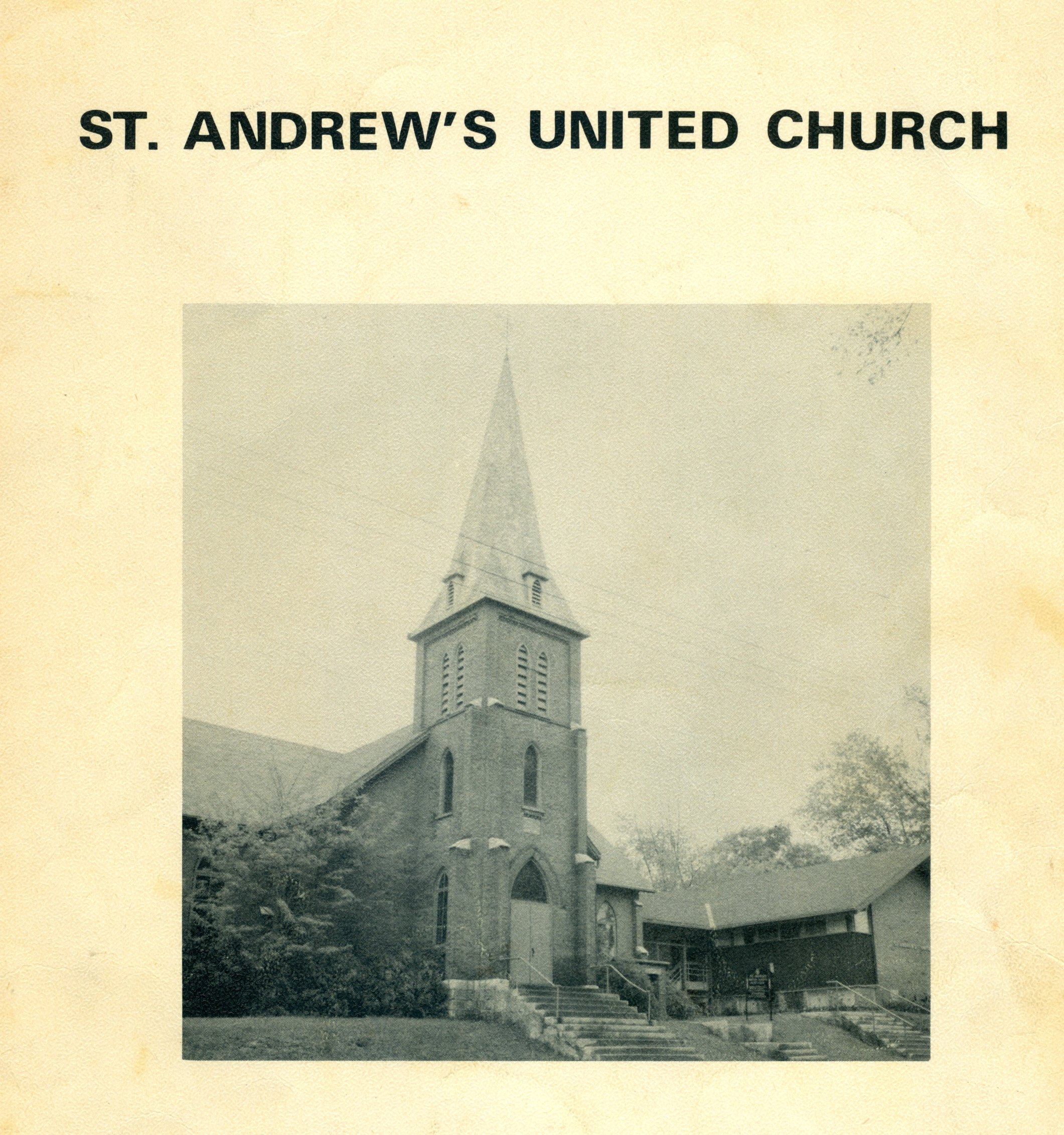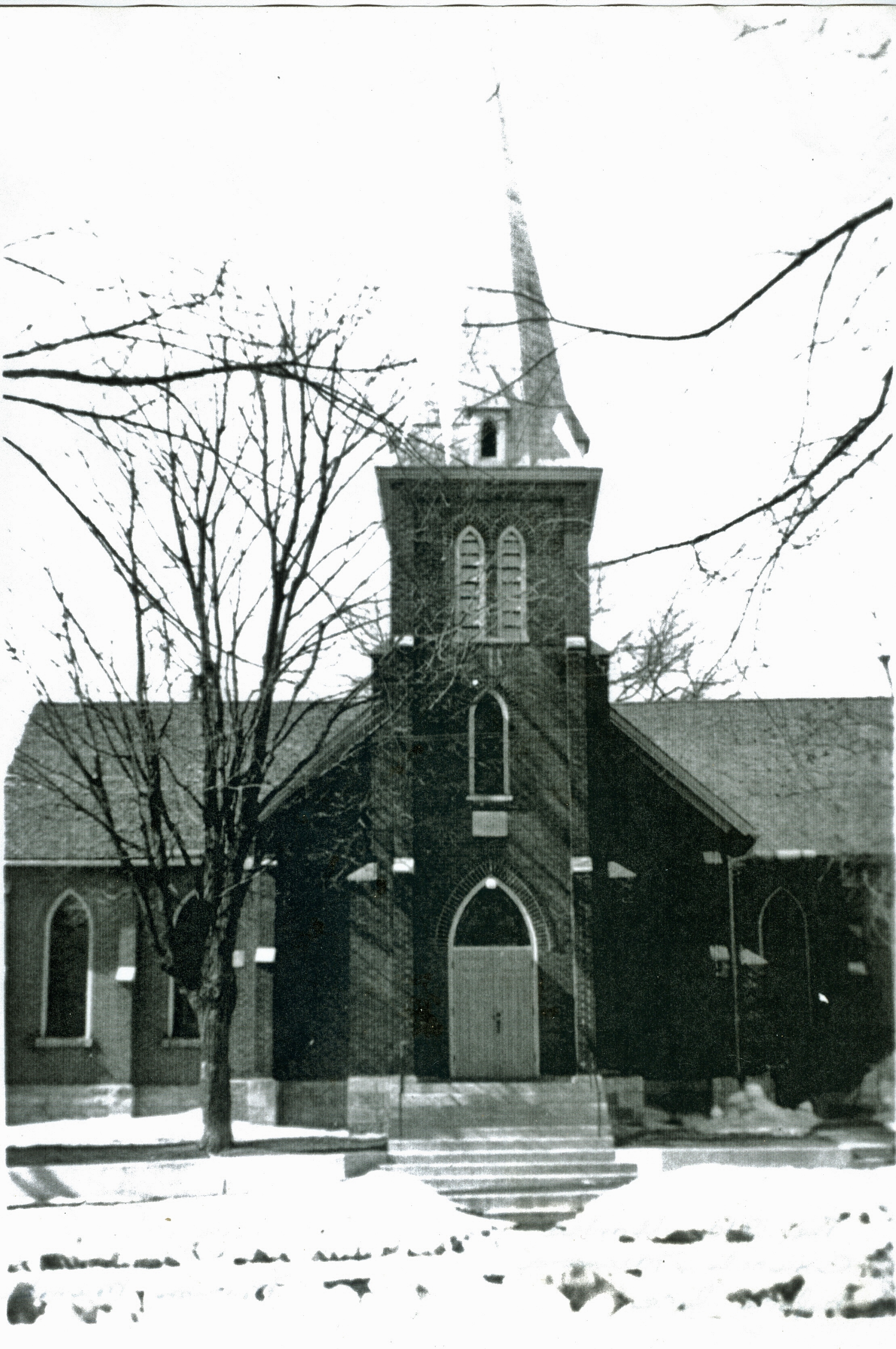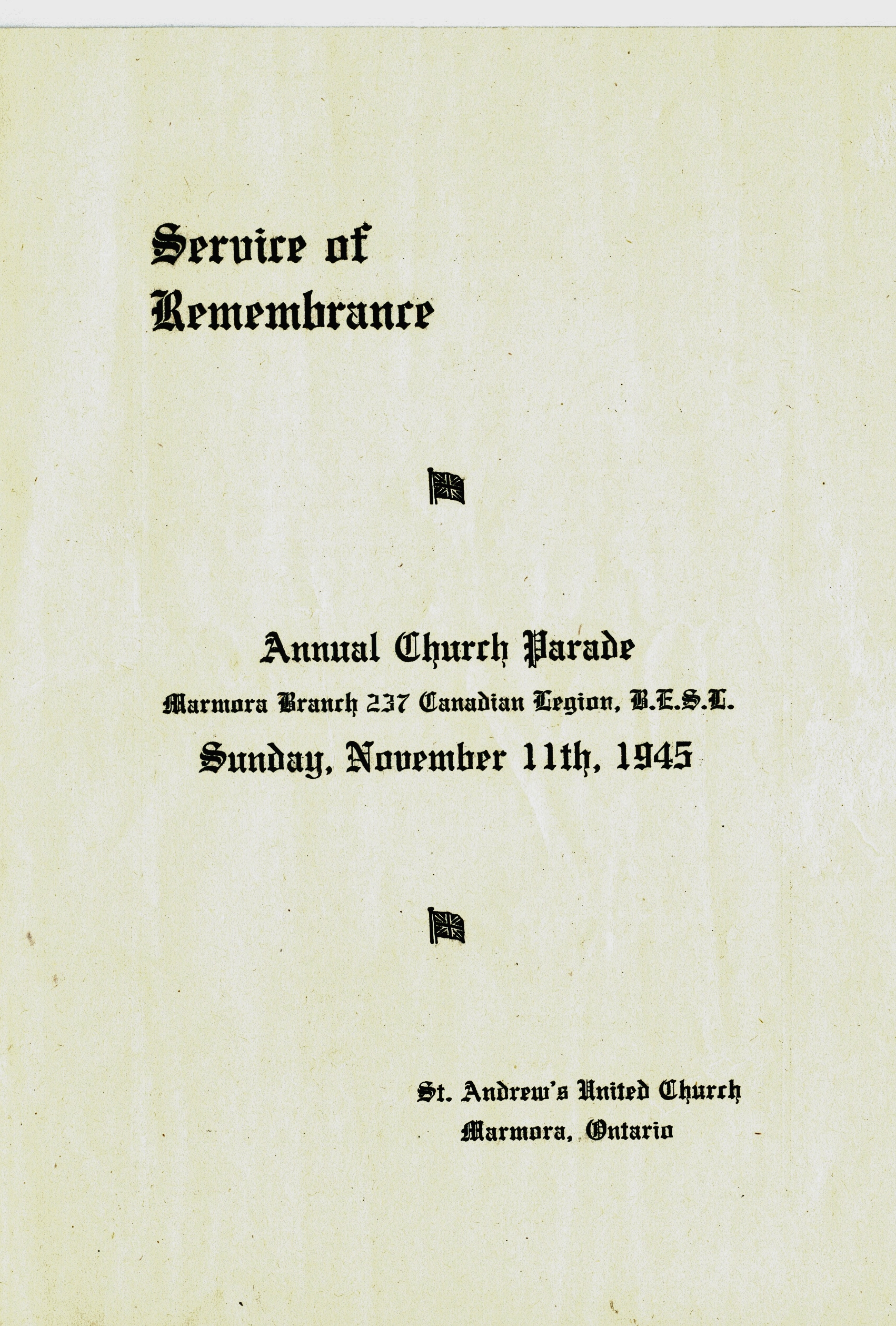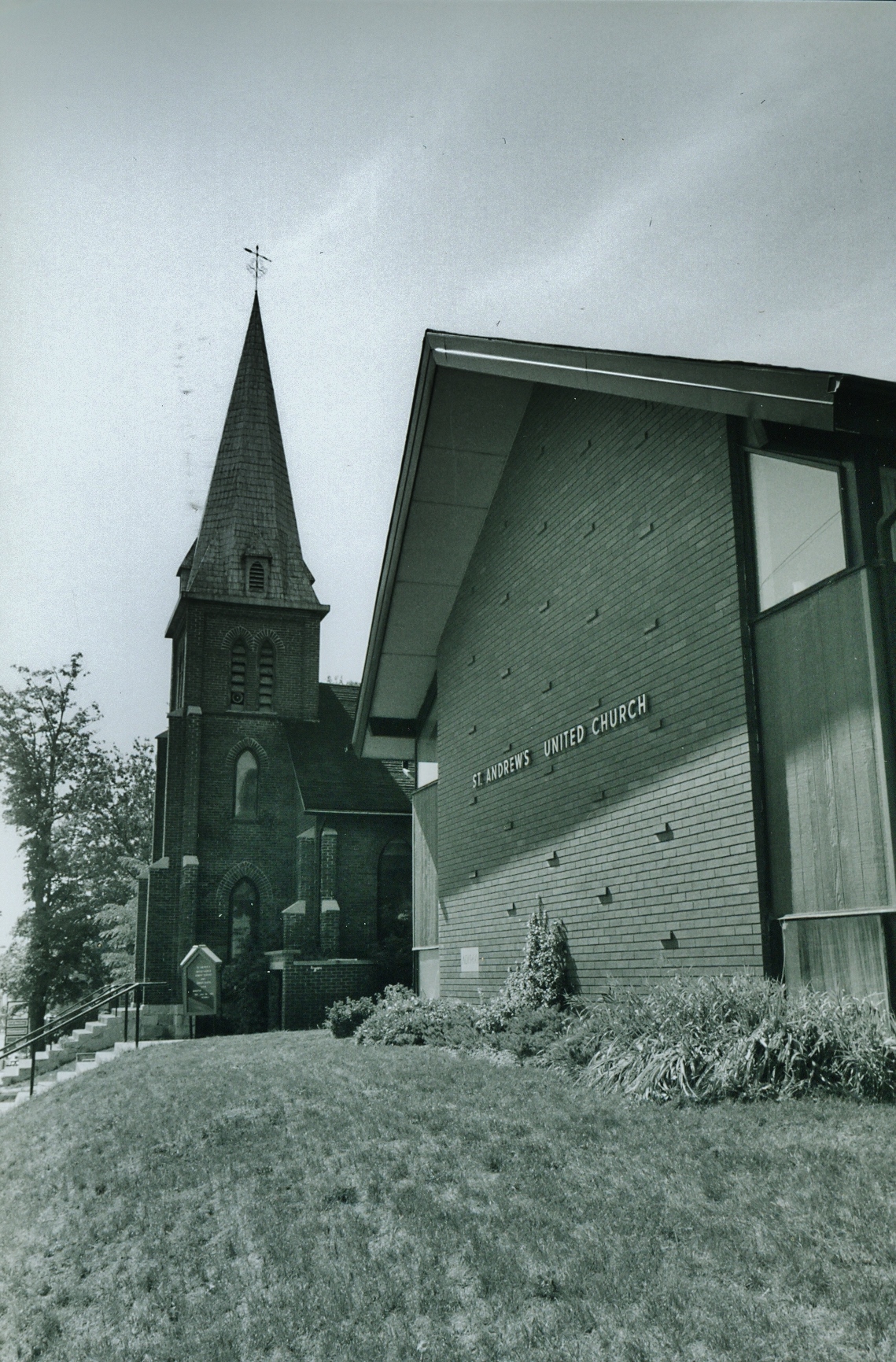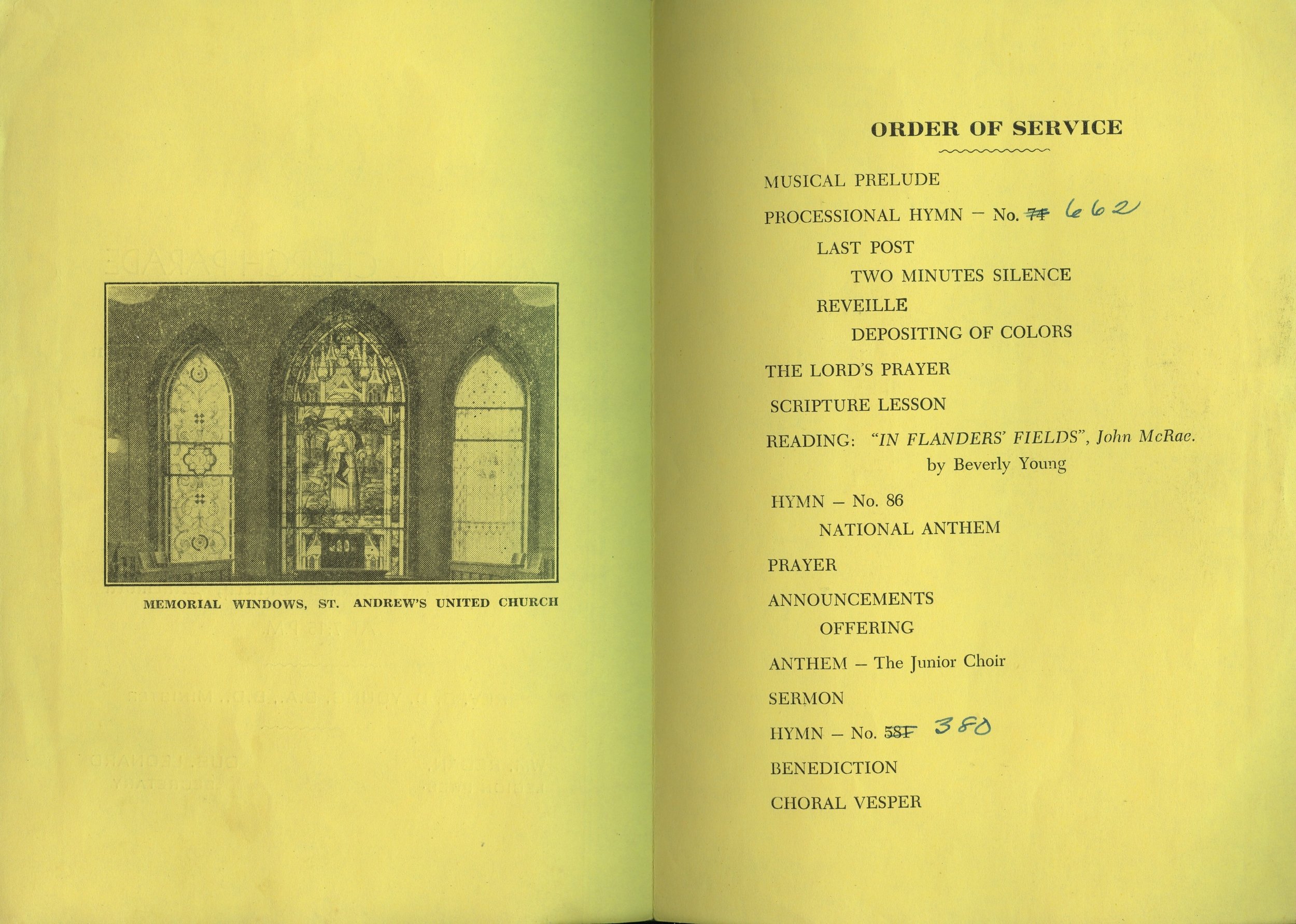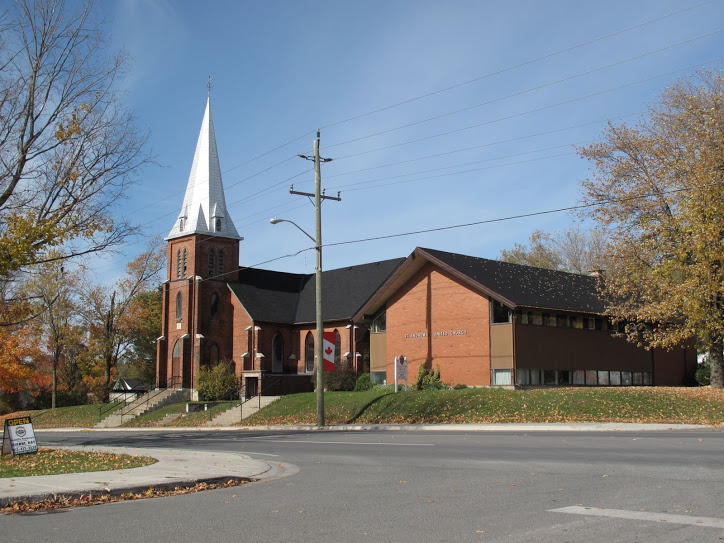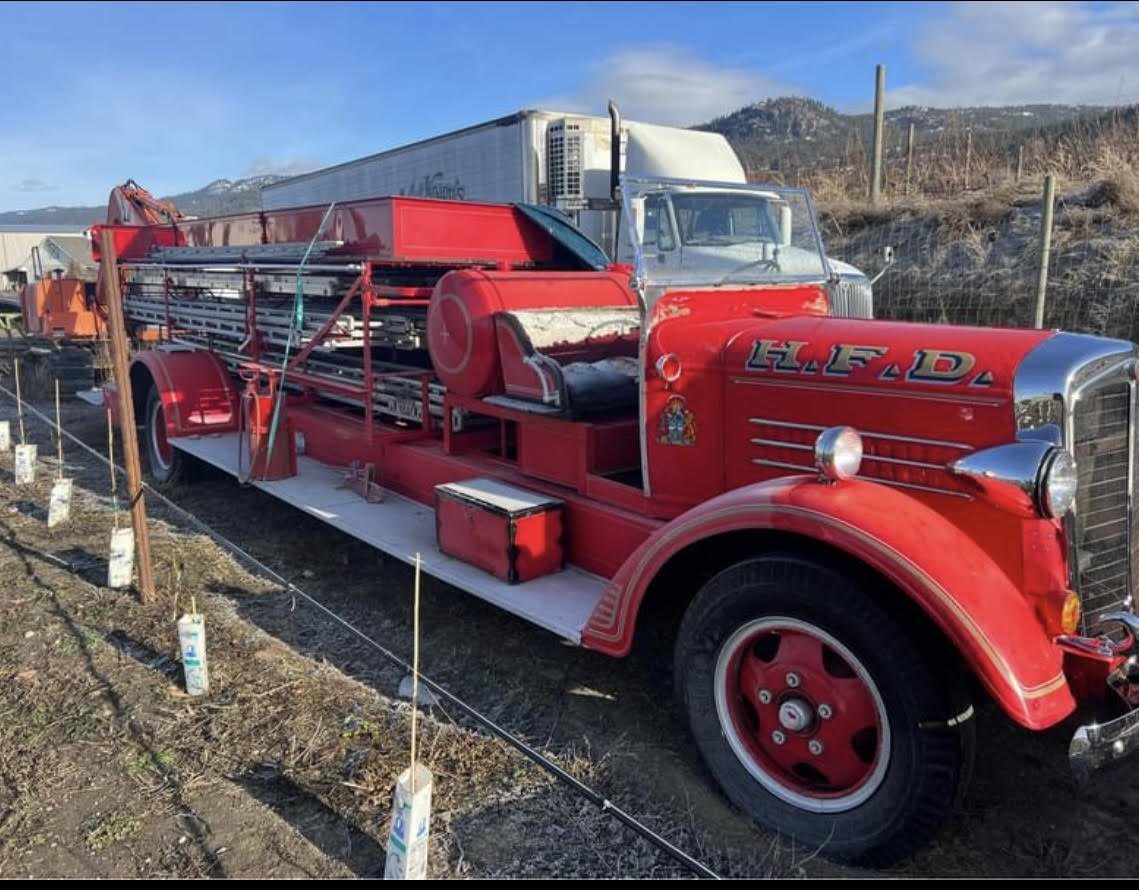ST. ANDREW'S UNITED CHURCH
33 Matthew Street, Marmora
Records contributed by St. Andrew's United Church
The Early History -
Over a century ago, Christians of all denominations contributed volunteer labour to, and worshiped in, a community Church, which was organized by Sacred Heart Roman Catholic Parish. By 1843, however, there were resident preachers in the Marmora area, representing the Wesleyan and Episcopal Methodist Churches, and the Presbyterian Church. With the Township Council's permission, congregations of the Marmora Methodist Church and St. Paul's Anglican Church, began to worship in the Old Town Hall until their churches were built. The first service in the Town Hall was conducted by Rev. Brown in 1848.
The first pastor to reside in the Village was Rev. Phillip Rose, in 1862. His grave can be found in the Marmora Common Cemetery. Two years later Rev. John Dowler began conducting services and settled into a yellow house on Reginald Street by the river, later owned by Mr. Ernest Gordon.
Plans for the Methodist Church were drawn up by Mr. John D. Evans and in 1868 the congregation began raising money for its construction. This first subscription list contained 129 names pledging $531.50.
Jim Nichol 1970 Bursthall St. Original UC parsonage in the background .
The First Manse: Rev. Doxsee and his wife Alma bought parts of Lots 7 and 8 on the east side of Bursthall street, in 1869, from the Cobourg-Peterboro and Marmora Railway Company for the sum of fifty dollars. This property was to be used for the future residence of ministers. In 1871 the Trustees of the Wesleyan Methodist Church bought the lot from them for the same sum of money. The manse, enclosed by a high board fence, was built on this location in 1872.
First Board of Trustees:
Peter Pearce of the Township of Belmont
Henry Jones,
Thomas Broadworth,
Richard Broadworth
John Brown,
Richard Gawley
Philip Banton
In 1874 the Trustees purchased the balance of Lot 7 on the corner of Bursthall and Matthew streets, from the aforementioned railway company for the sum of fifty dollars. The late Mr. T. P. Pearce, a member of the Building Committee, willed the lot east of the Church at his death. The Marmora Methodist Church was built in the summer of 1874. A mortgage for $1,500.00 was taken from the Canada Permanent Loan and Savings Company, for the remaining funds for the building, for a term of eight years. Some of the trustees pledged money of their own to pay off the debt.
Stone for the foundation was drawn by horses from the western side of Crowe River and was dumped on the road in front of the Church site. Mr. William Knox, with his yoke of oxen attached to a stone boat, drew the stone from the roadway to the foundation site and brick was bought from Mr. John Fidlar and Mr. James Kyle.
Years later, Mr William Knox became the caretaker f the church, and he and William Phillips, who served the Anglican Church in the same capacity, made a practice of having the bells strike alternatively.
The spire was tinned by Mr. Henry Warren of Stirling and the corner stone in the front of the Church was purchased for six dollars from Mr. S. W. Moore of Belleville. A silver trowel, suitably inscribed, was obtained from Mr. John Taylor, a Belleville jeweller. Church furniture was purchased from Mr. George Tickell of Belleville.
Pews were rented at three dollars for a long pew, and two dollars for a short one. At times of quarterly meetings, missionary meetings, and funerals all pews were free. The new Church had a cottage organ and Mrs. Benjamin Beddome, a talented musician, was the first organist. She had just arrived from England, and taught music in the village. A sexton was hired for twenty five dollars a year. He was to tend the fires for heating the Church, and light and clean the lamps.
The dedicatory and opening services were held on Nov. 4, 1874. One of Marmora's former residents, Mrs. John Green, later Mrs. Alex Anderson, had one of her children baptized that day. Mrs. Robert Lough, Mrs. Grace Aukland's mother, was one of the choir members.
In 1903 the wings were added to the church after over a thousand dollars had been subscribed. Rev R. McCullough was the minister when all the stained glass windows were put in place and dedicated.
During Rev. D.R. Clare's ministry in 1922 to 1925 the Board purchased the present manse at 27 Madoc Street, which is built on a double lot. In Oct., 1920, after acting as caretaker of the Marmora Methodist Church continuously for 30 years, Mr. William Knox resigned owing to ill health.
Patriotic Sunday
Church Union
In 1925 the congregations of the Methodist,Presbyterian and Congregational Churches of Canada became the United Church of Canada, after many years of study and preparation. Beginning in 1926, the Official Board invited a minister of its choice to serve the congregation. Rev. J.C. Beckley was the first to be called in this way.
Reverand McLeod 1958-1966
Reverand McLeod and Mrs. McLeod
Forty-one members were on the roll at this time. There were also ten branches in the surrounding district with a membership of one hundred and eighteen. These ten branches were known as:
Howes'
Jones'
McDowells'
Jones'
Branch Number 1 Beaver Creek,
Wileys'
Sprys',
Twelfth Line Rawdon,
Plunketts'
Tenth Line Rawdon.
The Spry Settlement Sunday School circa 1960. Brian Bronson added: “This picture taken at my grandparents farm, Nathan and Etta Bronson, 13Con., Rawdon Twp. My Grandma standing on the wagon, lady on far right. The farm is located on the Bronson Rapids Rd. About a mile south of the old Marmora Rd. At what they used to call the Townline Hill. . two boys on back of wagon Garnet and Ralph McCann. Seated on the wagon L to r Margaret Brownson, ??, Linda and Joan Bronson. Don’t ever recall a Jody Bronson, don’t know who that is in front of Grandma.or Jacqeline. Two girls on either side of Pearl Brownson I think are Helen and Evelyn MCCann. Annemarie is that you beside my cousin Linda. Annmarie Willman-Spry added: “ON THE WAGON: Mae McCann, Helen McCann, ?, Pearl Bronson, Nathan Bronson, Eva Empy, Shirley Empy, Jacqueline Bronson, Jim Bronson, Etta Bronson, Jody Bronson. Rettie Spry is on the ground with the hat.”
Sunday School Photo supplied by Pat Marett
The Circuit and Its Early Ministers
Owing to the large extent of the circuit, with its ten appointments outside the village, one minister was unable to do the work. An assistant minister was appointed. In addition, there were one to four local preachers and several exhorters, now known as counsellors.
In Rev. Cooke's time, 1873- 76, the minister's salary was three hundred dollars a year. He was also allowed three hundred and fifteen dollars for living expenses, seventy-five dollars for horse- keep, fifteen dollars for travelling expenses and incidentals, and thirty dollars for fuel. The second minister, a single man, received a salary of two hundred dollars, seventy-five dollars for board, and sixty dollars for horse-keep.
Two ministers were kept until 1882. In this year a Church was built at Springbrook with a circuit preacher from Marmora conducting services. These early Methodists tried to raise half of the finances within the circuit and the balance was supplied by mission funds. The rural appointments paid the greater part of their givings in home grown produce. The produce was reckoned according to its current value.
In 1877 during Rev. Peake's ministry, the local Presbyterian congregation asked for the use of the Church for their fortnightly Sunday afternoon services. This was granted on the condition that they keep the Church comfortably clean.
Formation of Circuit and Mission
In May of 1886 a request was made to the District Meeting, held at Madoc, to separate the Marmora Circuit into a Circuit and a Mission. The Marmora-Rawdon Circuit included the Jones and Spry Settlements, Springbrook, Rawdon and Marmoraa. The Mission of North Marmora was comprised of Zion, Beaver Creek, Hawes and Cooks.
This wedding photo of Harry Barrons and Edna Jackson, includes Pastor W.P. Fletcher, who was Pastor of St. Andrews from 1939 to 1944. He also took and interest in the United Church in Cordova, along with Rev. C.W. Hollingsworth. (The other two in this photo are Everett Barrons, brother of the groom and Ethel Forsyth, sister of the Bride. (Courtesty of Ron Barrons)
Fire!
In the early morning of a Sunday in January, 1944, the congregation was awakened and shocked to discover that fire had broken out in the church. Despite the energetic work of firefighters, the interior was gutted and the recently purchased organ, dedicated by ladies of the congregation, was destroyed. Previous to this disaster, the Board of stewards and the congregation had chosen Rev. E.M. Cadigan as their minister. When he heard of the fire, he came at an earlier date and organized the rebuilding fund. In the meantime, services were held in the town hall. On June 10, 1945 services were resumed in the renovated and altered church. The plan of the church was changed so that the congregation faced the beautiful stained glass window in the west. A new organ accompanied the singing.
The addition of the bright and roomy Education Wing in 1960 made possible a great variety of activities for people of all ages. Mr. Don Marrett.was chairman of the building committee when this addition was made to St. Andrew's. The final payment on it was made in 1972.
Mrs. Jones, Mrs. Litt and Mrs. Hungerford...1948
In the Marmora Herald:
St. Andrew's United Church Badly Damaged By Fire, April 27, 1944
During the fire at St.. Andrew's United Church last Sunday morning considerable disappointment was caused by the apparent lack of water pressure developed by the gasoline engine, which was installed three or four years ago. In the early stages, the pressure would hardly throw a stream of water 10 feet high. When the governors on the engine were adjusted, the pressure was a good deal better, "but was still far from satis- factory." Fortunately the priority has now been obtained to purchase a speed-up unit, which should make a very great difference in the speed and power of the engine. Efforts to obtain the unit have been made from the time the engine was installed, but authority to import was only given recently. It is expected it will be installed within a week or two and the :fire protection system should then be given a thorough test.
About eight o'clock Sunday morning a. fire alarm sounded and it was found fire had broken out in St. Andrew's United Church. The fire was caused by the heat of the furnace pipe igniting the wooden ceiling above it. Mr. G: W. Henderson, the caretaker, had started the fire a short time previously and the first filling of the furnace had burned out. He filled it again, putting in a couple of sticks of hardwood and some pine and softwood slabs, and then went to the main body. of the church, to do some dusting and other 'work.
Suddenly he noticed smoke coming up and hurried down to the furnace room, where he discovered the ceiling was on fire. He first sounded an alarm on the bell and then took a couple of pails and hurried for water. Wilbert Bedore joined him at the pump and rushed to the church with one pail of water, Mr. .Henderson carrying the other, but when they reached the furnace room the smoke was so dense they could not get into it. The caretaker tried to go in, but fell and was almost overcome by the smoke having difficulty finding his way out again. By that time people were gradually gathering and a difficult and stubborn fight to save the church started. The chemical engines were soon brought up and then a string of hose was run from the hydrant near the memorial building to the church, but it was almost impossible to get at the blaze, owing to the dense smoke. For a time the water pressure was very low and the fire appeared to be gaining headway all the time. A couple of gas masks were borrowed from Deloro Smelting & Refining Co, Limited and it was then possible to enter the basement and get at the blaze. By that time the floor of the choir loft was blazing fiercely underneath and around the new organ, which was completely destroyed. . At one point the fire burned up between the outer and inner wall almost to the roof and a couple of small holes had to be cut through the ceiling of the church to get water on the fire. Most of the ceiling in .the basement also had to be torn off as the fire kept spreading under the floor.
That the walls and roof and the big memorial window were saved was entirely due to the splendid efforts of quite a number of fire fighters, who, in spite of smoke, which almost, blinded and choked them, and intenseheat in some parts of the building, carried on although they were soak- ing wet and almost exhausted. The fine community spirit which exists in Marmora, was again in evidence in the fact men of all denominationsworked side by side to save thechurch. Until experts have time to assess the damage, it is impossible to say what the loss will be, but estmates, place it at $10,000 or .more. As soon as the insurance is adjusted and plans can be completed, it is planned to start the work of restoring the church. The members of the Official Board and of the congre-gation very much appreciate the generous offer of therector and officials of St. Paul's Church for the use of St. Paul'sChurch, but have decided to hold services in the town hall until St. Andrew's can be restored. The kindly expression of sympathy extended by Rev. Fr. H. J. Farrell, onbehalf of himself and his people, at Sacred Heart Church on Sunday morning is also appreciated. A special meeting of executive of Belleville Presbytery was held on Monday and Rev.' A. Poulter, of Madoc, secretary of the Presbytery, was requested to personally convey their sympathy with the officials and members of the church in the loss which they have sustained.
KIM WARNEMinister in 1997
Click on the phototo read more about Rev. Warne & his art
Mrs.Dick Koleski, Marg Gray, May Madgett
SOME OF THE 1974 FLOCK
MEMORIES:
Al Grant many fond memories--Wayne (VanVolkenburg) and I taking up the collection --me singing (trying) in the choir--- Ralph Neal singing (trying ) in same seat every Sunday-- taking turns ringing the church bel
Terry Bell Still have the bible I was awarded for perfect attendance by Sunday School teacher Frank Marrett in 1959.















